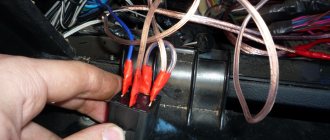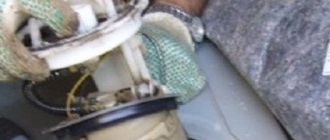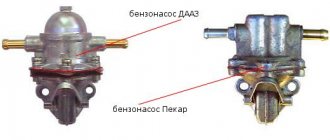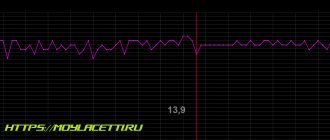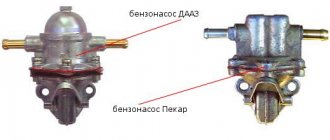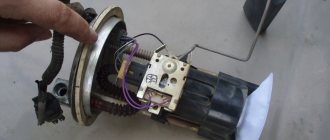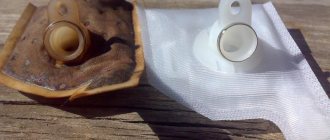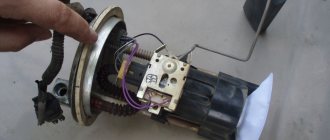The VAZ 2114 has an injection engine with a volume of 1.5 and 1.6 liters. Such engines are equipped with a large number of sensors, as well as electronic fuel supply under pressure. Quite often it happens that a breakdown occurs in a car and fuel stops flowing to the engine, thereby preventing it from starting. It is quite difficult to find the cause of a fuel pump failure on your own, but after studying our article, you can easily determine the culprit of the breakdown and solve the problem as soon as possible.
In this article we will talk about the breakdown of the fuel pump on a VAZ 2114, namely why this part stopped pumping fuel.
Design and principle of operation of the fuel pump
In order to find the cause of the breakdown, you must first know the design and operating principle of the fuel pump.
Design
The gasoline pump is made of many parts and resembles an electric DC motor. Its body is made of plastic and metal; inside the body there is a magnet and a rotor, on the shaft of which an impeller is mounted on one side, and a current collector on the other. The fuel pump itself is a brushed motor, which greatly reduces its reliability; many modern cars (foreign cars) have already switched to brushless electric pumps.
One of the important elements of the pump is the check valve, which maintains the built-up pressure in the system and does not allow it to flow back into the tank through the valve.
Principle of operation
When voltage appears on the fuel pump block, it begins to rotate, the impeller pumps fuel into the system, as soon as it reaches the required amount, the fuel pump valve closes, thereby closing the path to the outflow of fuel back into the tank. After which you can start the engine. You can clearly hear the operation of the fuel pump by turning on the ignition and listening to its operation. The fuel pump will make a characteristic squeak and stop after a few seconds - this will mean that the pressure has been pumped into the system.
Motor
Fuel pump motor VAZ 2114
We checked the pressure and wiring, everything works like clockwork, but the engine stalls. The fuel pump may not pump due to a breakdown of the motor - the main element that drives fuel. We check its functionality with the same light bulb: attach its wires to any terminal of the motor, turn the ignition. The lamp blinked - it was time to throw out the motor. And again, run to the store for a brand new motor.
The terminals may oxidize and not make contact, as a result of which the fuel pump will not pump. The motor in this case may be normal. And the terminals just need cleaning (possibly re-soldering). There is an opinion that the terminals are oxidized due to low-quality fuel (the octane number does not match the declared one).
Fuel pump system
The fuel pump itself does not work; it is part of a special station, the so-called “fuel pump cup”. This part is a bracket for mounting the fuel pump in the tank. Also, a special coarse fuel filter is put on the fuel pump, which allows you to keep the fuel pump from dirt getting into it. A fuel level sensor and a fuel pressure regulator are installed on the glass. Together, all these parts form the fuel pump station, or popularly the “glass”.
Symptoms of a problem
There are many signs of a fuel pump malfunction and they are all similar to each other, and they can also be confused with breakdowns in other elements of the fuel system, such as injectors, filters, RTDs, etc. Signs of malfunction in fuel system elements are always similar, but the fuel pump has its own factor that can clearly indicate its malfunction - the sound of its operation.
Any pump, even the highest quality and new, should make a sound when operating. If there is no sound, then something is definitely wrong with the pump.
Possible symptoms of failure:
- Loss of vehicle dynamics;
- Difficulty starting the engine (the starter turns for a long time);
- The car stalls when you press the gas pedal;
All these problems can be caused by other fuel cells. For example, clogged injectors can also affect poor starting and loss of vehicle dynamics.
Where is the fuel pump fuse in a VAZ-2114 car?
Sometimes this system needs repairs - there is nothing complicated here, and the editors of the 2Skhema.ru website will tell you how to do it yourself. Let's start with the BN pinout, then we will indicate it on the diagrams and at the end there will be instructions for replacing the fuel supply elements.
- Reduce pressure in the fuel supply system.
- Using the fuel supply hose tip clamp, disconnect 2 hoses in turn.
- Unscrew the 8 nuts around the circumference of the clamping ring and remove it.
- A wire with negative polarity is attached to one of the nuts; it must be removed carefully.
- We take the electric pump block out of the fuel tank, tilting it slightly, to keep the fuel level indicator sensor lever intact, otherwise it will produce incorrect parameters.
- Remove the sealing rubber ring of the fuel block. If its properties are lost, the product must be replaced.
- Install the pump in reverse order.
When installing fuel hoses, focus on the direction of fuel supply indicated by the arrows, and the installation arrow on the electric pump cover should point towards the rear of the car!
In appearance, it is a small box that resembles a “plug” with an American type of output. Each terminal has a marking that indicates the following: 31 – mass; 30–12V constant (regardless of ignition); 15–12 with the ignition on; 50–12 when the starter is working; TD – signal from the ignition system;
But sometimes the fuel pump does not turn on when the key is turned in the ignition. With what it can be connected? First of all, the fuse, although if it had blown, it would not work at all. Maybe the contact is bad?
If the electric fuel pump does not show any signs of life when the ignition is turned on, this does not mean that it has burned out. The cause of the malfunction may also be a relay. The easiest way to test your hearing is that when you turn on the ignition, the relay should click. If you don’t hear a click, there is a high probability that the “relay” is faulty.
It’s easy to check the functionality of the pump itself, so we do this:
- remove the protective casing, under which there is a block with relays and fuses;
- we unscrew the fastenings of the block, remove it, it remains attached to the wires;
- we pull the RB out of the block, place a jumper between two opposite contacts, thus directly supplying power to the BN;
- if with such a connection the electric motor of the pump begins to make noise, it means that the BN itself is working, most likely the fault is hidden in the relay;
- if there is no voltage on any of the contacts on the RB block, you should look for a break in the wiring; there may also be poor contact at the place where the wire is attached to the terminal.
If there are obvious signs of combustion on the fuel pump safety device, replacing it will not be enough. You will also need to check other details:
- the entire section of the current-carrying circuit for breaks in it;
- pump relay (may stick);
- fuel pump contacts (terminals may oxidize);
- the fuel pump itself.
According to the marking, the safety element accepts a current of 15 A; you can find a similar one for sale in specialized stores without much difficulty.
Experts warn that if the breakdown problem lies not in a blown fuse, but in another part or in the wiring itself, replacing it will not be enough. It is necessary to determine the reason why this element failed. If this is not done, the new fuel pump fuse will burn out in the same way as the previous one.
The following signs may indicate that the VAZ 2114 fuel pump is not pumping:
- The engine will not start.
- After working for a short time, the motor stalls.
- The engine is tripping.
- The engine often jerks at low speeds.
- The pressure in the fuel rail (rail) has dropped. Normally, it is: for a volume of 1.5 l - about 300 kPa (/-20 kPa), for a volume of 1.6 l - 380 kPa (/-10 kPa).
- After turning the ignition key, the vibration of the fuel pump is not heard.
If your car has the above “symptoms”, then you should not immediately rush to conclusions. Many of them are quite general, characteristic of a number of problems, and only the last three signs clearly indicate a fuel pump malfunction.
There may be several reasons why this particular device failed, including:
- fuse burned out;
- Fuel pump relay 2114 broke;
- the mass contact has come off or oxidized;
- the fuel pump contacts have oxidized;
- the electric motor burned out;
- The pump itself has failed.
The search should begin, as in most other cases, by checking the fuse. The VAZ 2114 fuel pump fuse is located in a small black box located on the housing of the electronic control unit. It is designed for a maximum current of 15 A, and its socket is marked fuel pump.
If the reason is not in the fuse, then the next step is to check the condition of the relay. True, here many motorists may ask a logical question - where is the fuel pump relay on the VAZ 2114, because it is not in the common unit? You can find this electronic device next to the handbrake lever, under the dashboard. To open access to it, you will have to remove the plastic around the handbrake.
To check the serviceability of the relay, simply turn the ignition key in the lock and listen carefully. If the relay is working properly, a characteristic click will be heard. If it fails, the device will not make any sound. A broken relay should be replaced with a new one, since this device is not repairable, and it does not cost much.
After checking the relay, you should also check the ground contact located not far from it (when manipulating the relay, it will be clearly visible). The contact should be cleaned and its fastening to the steel body of the car tightened.
If after all the above steps the fault cannot be found, it is worth checking the condition of the contacts in the fuel pump wiring and the wiring itself. The latter can be done by regular testing using a multimeter. If a wire break is detected, it should be repaired - there is nothing complicated here. If it turns out that the wiring is working properly and voltage is supplied to the pump, but it does not work, you should check its contacts.
On the fuel pump body there are not two, but three connectors - positive, negative and control (for the fuel level). Connect a 12 volt light bulb to the positive and negative connectors and turn the ignition key. If the contacts are working properly, the light will light up.
If this does not happen, you should thoroughly clean the contacts with fine sandpaper or a cloth with kerosene, and then carry out the experiment again. If the light does not light up again, then the reason lies deeper.
The next step in troubleshooting the pump should be to check the functionality of its motor. This can be done using the same lamp - by connecting the lamp contacts to the motor connected to the on-board network, you should turn the ignition key.
If the light bulb does not react, you need to thoroughly clean the contacts of the electric motor, and then repeat the experiment. If the light blinks and the motor does not react in any way to the incoming voltage, then it is out of order and it’s time to buy a new one.
In some cases, even after cleaning the terminals, a working motor may not respond to turning on the power supply. In this case, you can try to re-solder the terminals by removing the layer of solder from them and applying it again.
If it turns out that the relay for the VAZ 2114 fuel pump, the motor, the ground contact, and all other electrical elements of the circuit are working, all that remains is to replace the damaged pump with a new one.
You can do it like this:
- Disconnect the battery ground terminal.
- Drain the fuel from the tank.
- Remove the rear passenger seats.
- Remove the plastic cover covering the pump.
- Disconnect the wires and hoses going to the pump.
- Unscrew the fuel pump fasteners using a size 7 wrench.
- Remove the pump from the tank.
Installing a new fuel pump is done in exactly the same order, but in reverse order.
The price of this unit starts from 100 rubles. A fuse can be bought for 10-15 rubles.
The non-pump is one of the key components of the VAZ 2114 fuel module. The gasoline pump helps ensure that gasoline is supplied to the engine at the required level of pressure.
Fuel pump for VAZ 2114
Any guarantees from the manufacturer with the actual service life of the fuel pump have little in common, since its durability directly depends on the operating conditions - even the highest quality VAZ fuel pump can quickly fail due to bad gasoline.
A faulty fuel pump is quite easy to identify, since it is characterized by characteristic signs of failure. For example: while driving, the car suddenly stalls - after turning it on again, the engine begins to make uncharacteristic sounds, while the starter does not stop turning. After the car starts up, the picture repeats itself - the fourteenth engine stalls again. It is also possible that the car starts every once in a while - problems usually arise after sitting at neutral speed.
Let's determine the most typical signs of a fuel pump malfunction:
- The engine refuses to start. Of course, there can be many reasons for this problem - the same spark plugs, or the ECU, but the possibility of a fuel pump malfunction is also worth taking into account;
- The pressure level in the fuel relay differs from normal values;
- The motor is tripping. As a rule, if the fuel pump does not pump as it should, the engine begins to twitch quite noticeably because gasoline is not burned properly in the working cylinders;
- The engine growls at low speeds. One of the most truthful signs, which indicates either an immediate breakdown of the pump, or that the low-purity filter is clogged and the mesh needs to be replaced.
There are quite a lot of possible breakdowns that could cause the fuel pump to fail. The following parts of the unit design can present an unexpected surprise: fuse, fuel pump relay, ground, electric motor, contact system. Let's look at each of them separately.
- Driver, head at “10”;
- Flat head screwdriver;
- A set of new modules;
- Plastic pliers for removing the relay block;
- Rags, additional lighting as needed.
Checking the fuel pump
To check the fuel pump, you need to measure the fuel pressure in the fuel rail and check the pump itself for pressure “into the wall”.
To check the fuel pressure, you need a special device, a fuel pressure gauge; you can also use a regular pressure gauge with a hose, connecting it to the ramp through clamps.
- On a car with a 1.5-liter engine, the pressure in the fuel rail should be: 2.7-3.4 bar;
- On a car with a 1.6-liter engine, the pressure in the fuel rail should be: 3.5-4.0 bar;
Then the pressure of the fuel pump is checked, which it presses into the wall; for this it must be dismantled (on 1.5-liter engines you can simply clamp the return line). In this way, the power of the pump is checked when checking the pressure “into the wall”; a good pump presses pressure up to 8 bar.
Why doesn't the fuel pump pump?
If the fuel pump has stopped pumping fuel pressure, then starting the car is out of the question.
Possible reasons:
- The fuel pump fuse has blown;
- The fuel pump relay burned out;
- The fuel pump burned out;
These three reasons are the main reasons why the fuel pump on a VAZ 2114 stops pumping fuel.
Finding the reason
The first thing you need to do is make sure there is voltage at the fuel pump, and it can go out for several reasons: a blown fuse or relay, burnt-out wiring.
Inspect the fuel pump fuse for integrity. It is located under the center console at the feet of the front passenger. It is necessary to remove the decorative cover of the leg air duct; there you can find three fuses and three relays. All of them must be intact.
You can check the relay using a multimeter by setting the switch to continuity, connect the probes to the relay coil, it should show some resistance. If the multimeter shows an open circuit, then the relay is faulty and requires replacement.
If the whole thing is most likely burned out, the fuel pump must be dismantled to do this.
VAZ 2114 fuel pump relay is one of the reasons for fuel system failure
VAZ 2114/2115 cars are equipped with 1.5 cm3 and 1.6 cm3 gasoline engines with a distributed injection system. A submersible electric fuel pump is used to supply fuel.
It is part of the fuel module installed at the top of the gas tank (under the rear seat).
In addition to the pump, the module includes a fuel accumulator (cup), a coarse filter and a fuel level sensor with a float.
To supply fuel in VAZ 2114/2115 cars, a submersible electric fuel pump is used
The VAZ 2114/2115 fuel pump is a conventional DC electric motor in a sealed housing with a one-way valve at the outlet. An impeller of a special shape is located on the electric motor shaft. Its rotation ensures the fuel supply.
The fuel module includes a fuel pump, a fuel accumulator, a coarse filter and a fuel level sensor
The fuel pump is powered from the vehicle's on-board network. The electrical circuit of the pump, protected by a fuse, is closed using a separate relay.
Electric fuel pumps for VAZ cars are produced by both domestic (Utes, SAAZ, Pekar) and foreign companies. The latest modifications of the VAZ 2114/2115 are equipped with BOSH pumps, which are distinguished by their high reliability, long service life and relatively low price.
Design of the electric fuel pump VAZ 2114/2115
Catalog numbers of standard fuel pumps for VAZ 2114/2115:
- 2112–1139009–12 — for engines with a volume of 1.5 cm3;
- 2112–1139009–01 — for engines with a volume of 1.6 cm3;
- 580453453 (BOSH) - for engines with a volume of 1.5 and 1.6 cm3.
These models differ in operating pressure. The former are capable of creating a pressure of 2.8–3.2 kPa in the fuel system, the latter - 3.7–3.9 kPa. BOSH fuel pumps are rated at 3.5 kPa.
A malfunction of the fuel pump of VAZ 2114/2115 cars can be diagnosed by the following symptoms:
- when the ignition is turned on, there is no sound of the pump running;
- the engine does not start or starts with difficulty;
- the power unit is unstable at idle, the speed “floats”;
- “dips” appeared during acceleration;
- the motor has lost power.
The same signs also appear when other elements of the fuel system malfunction.
Before you begin diagnosing or replacing the fuel pump, you should make sure that:
- the fine fuel filter is not clogged (it is changed every 7 thousand kilometers);
- the injectors and fuel pressure regulator are operating normally;
- The sensors for mass air flow, throttle position, and oxygen quantity are working properly.
If the detected malfunction is accompanied by the lighting of the “CHECK” lamp on the dashboard, you should set the error code and decipher it.
Diagnostics
A malfunction of the VAZ 2114/2115 fuel pump can be caused by:
- malfunctions in the device’s power supply circuit;
- failure of starting and protection elements (relay and fuse);
- wear of electric motor parts.
At the beginning of the diagnosis, you should check the electrical circuit of the fuel pump. To do this you will need:
- car tester (multimeter);
- crosshead screwdriver;
- two pieces of wire about 2 m long.
Checking the electrical circuit is carried out in the following order:
- Turn on the ignition without starting the engine. When the key is in the first position, a click should be heard, characteristic of turning on the relay, followed by a slight whirring of the pump electric motor. If there is no click, the relay is faulty or is not receiving power. If there is a click, but no buzzing, the wiring coming from the relay or the pump motor itself is faulty.
- Under the glove compartment, find an additional mounting block consisting of three relays and three fuses. The pump relay is located in the middle, and the fuse is located to the left of it. Remove the fuse from its socket, test it with a multimeter, and if the result is negative, replace it. When replacing the fuse, please note that it is rated for a maximum of 15 A.
The relay and fuse for the fuel pump on the VAZ 2114/2115 are located in the mounting block under the glove compartment.
- Set your multimeter to voltmeter mode. Connect one probe of the device to the relay terminal to which the pink wire fits, and the second to the car body. Turn on the ignition. The device should show the on-board voltage in the range of 11.7–12.4 V.
If there is no voltage, the problem may be a broken wiring or a malfunction of the ignition contact group. In this case, it is better to contact an auto electrician. If power is supplied, check that the relay is working.
With the ignition on, use a screwdriver or a piece of wire to close the contacts to which the pink and gray wires go. This closes the circuit bypassing the relay. If the fuel pump works, replace the relay.
- Be sure to check the connection of the pump's negative wire to ground. Often it is the lack of “ground” that causes interruptions in the operation of the fuel pump. Remove the plastic trim from the center console near the parking brake handle. Under it there is a “negative” wire of the pump, screwed to the body with a self-tapping screw. Unscrew it, clean the contacts, screw it back and repeat the test.
The ground wires of the fuel pump are attached to the body with a self-tapping screw
- Then check the fuel module. Remove the rear seat, peel back the carpet and sound insulation. Unscrew the two screws securing the gas tank flap and disconnect the electrical connector on the fuel module cover. Using two wires, supply power to the pump directly from the battery. If the pump works, the wiring is faulty; if it doesn’t work, the pump itself is faulty.
Pressure check
If the pump is working properly, but the engine begins to operate intermittently, you should check the fuel pressure in the system. For this you will need:
- pressure gauge (can be a tire gauge with a measurement limit of 5–7 kPa);
- petrol-resistant hose with a diameter of 10–12 mm and a length of 50–80 cm;
- two clamps for a hose of the appropriate diameter;
- Phillips screwdriver;
- nipple cap;
- dry rag.
In addition, the presence of an assistant is desirable.
The verification procedure is as follows:
- In the engine compartment on the engine fuel rail, locate the pressure measuring fitting (on the right side).
- Remove the plastic cap (plug) from the fitting.
Find the pressure fitting and remove the cap from it
- Using the nipple cap, unscrew the spool valve from the fitting. When unscrewing the spool valve, fuel may spray out of the fitting. To remove it, use a dry cloth.
When unscrewing the spool valve, fuel may spray out of the fitting.
- Place one end of a gas-resistant hose onto the fitting and secure the connection with a clamp. Connect the other end of the hose to the pressure gauge fitting and also tighten the clamp.
Connect the pressure gauge to the fitting using a hose and clamps
- Ask an assistant to turn on the ignition. Wait a few seconds and watch the meter readings. With a working pump, the pressure gauge should show a pressure of 2.8–3.2 kPa for engines with a volume of 1.5 cm3 and 3.7–3.9 kPa for engines of 1.6 cm3. If the pressure is noticeably higher, the pump is faulty.
Russian car owners prefer BOSH fuel pumps. You should only buy a new pump in specialized stores. The original product must be packaged in thick plastic film filled with special preservative oil. At the same time, a branded BOSH pump cannot cost less than 2 thousand rubles.
The engine control system circuits are protected by three fuses.
Location of relays and fuses for the engine management system under the instrument panel console
Note. The right trim of the instrument panel console has been removed (see “Instrument panel - removal”).
Relays and fuses of the engine control system: 1,2 and 6 - fuses (see table 8.4.3); 3 - main relay; 4 — relay for turning on the electric fan of the engine cooling system; 5 - fuel pump activation relay
| Position in the photo | Current strength, A | Protected Circuits |
| 1 | 7,5* | Electronic control unit (ECU), ignition module |
| 2 | 7,5* | Coil of the cooling system electric fan relay, canister purge valve, air flow sensor, speed sensor, oxygen concentration sensor |
| 6 | 15 | Fuel pump |
* On cars of the first years of production, 15 A fuses were installed.
The fuse and relay mounting block contains tweezers for removing fuses (see “Fuse and Relay Mounting Block”).
A faulty fuse can be identified by a blown thread.
Recommendation: Sometimes the fuse thread remains intact, while its connection inside the fuse is broken. It is impossible to visually determine such a malfunction. In this case, you can assess the condition of the fuse using an ohmmeter.
Warning! Before replacing the fuse, the cause of the blown fuse must be determined and eliminated. To avoid failure of elements of the engine control system, do not install fuses with an increased rating or homemade ones.
Buying a fourteenth fret is a young thing that does not require a large budget, both for the car itself and for spare parts.
If you compare the VAZ 2114 with any foreign car of the same class, you will get a decent price difference in favor of the Lada.
And even if a foreign car costs more, and servicing it is not more expensive than a Lada, then spare parts from the Russian automobile industry will be much easier to find in any of the most remote areas of our country.
Whatever you say, any car wears out and requires attention and care. So let's talk about a common problem with the fourteenth - the fuel pump does not pump.
Gasoline pump VAZ 2114
You're driving, and suddenly you stall. You start it, the engine growls, the starter turns, it starts moving and again there is a stupor. Or the ignition does not respond at all, you have to push it to start. This also includes the case when the engine responds every once in a while if you slow down for a couple of minutes and go to nitral. The battery is ok. We're sinning at the fuel pump.
If the fuel system on a VAZ-2114 begins to malfunction, then experienced specialists warn that the problem may lie in the fuel pump fuse. Where is this part located? What functions does the fuel pump fuse perform? What are the reasons for its breakdowns? Answers to such questions can be found in this article.
The fuel pump safety device, not only on the VAZ-2114, but also on other passenger cars, is just a small element in the vehicle’s fuel system. It has a relatively small size, but carries an important functional load.
- the outer casing is made of plexiglass;
- inside the device there is a conductive element made of plates and fusible material;
- the body is marked in the form of the Latin letter “F” (this designation indicates that the safety device is intended for an electrical circuit with low power).
- Open the hood lid.
- Find the plastic box on the engine control unit.
- Open the small unit, which opens and closes with latches.
- Find the appropriately marked safety device (located at the top).
- Remove the safety element:
- for this you will need forceps, tweezers or a clamp;
- grab the safety device with a tool;
- pull the fuse towards you;
- remove from the nest.
- Perform a visual inspection of this device:
- cracks and chips on the body;
- burnt fusible materials inside;
- carbon deposits on the internal plates;
- contacts are damaged.
- Short circuit or other faults in the current-carrying circuit.
- Failure of the components of the power circuit.
- The fuse itself is defective.
- The anti-theft alarm contacts are connected incorrectly.
- open the hood;
- look towards the windshield;
- there is a plastic box on the ECU;
- This box contains the fuse we need.
- 2112–1139009–12 - for engines with a volume of 1.5 cm 3;
- 2112–1139009–01 - for engines with a volume of 1.6 cm 3;
- 580453453 (BOSH) - for engines with a volume of 1.5 and 1.6 cm 3.

